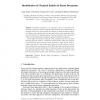440 search results - page 80 / 88 » Artificial Neural Network for Sequence Learning |
IWANN
2009
Springer
14 years 1 months ago
2009
Springer
Biomedical literature is an important source of information for chemical compounds. However, different representations and nomenclatures for chemical entities exist, which makes th...
ISMB
1993
13 years 8 months ago
1993
Weintroduce a parallel approach, "DT-SELECT," for selecting features used by inductive learning algorithms to predict protein secondary structure. DT-SELECTis able to ra...
BMCBI
2007
13 years 7 months ago
2007
Background: Much recent work in bioinformatics has focused on the inference of various types of biological networks, representing gene regulation, metabolic processes, protein-pro...
IWANN
2009
Springer
14 years 1 months ago
2009
Springer
In Biomedical research, the ability to retrieve the adequate information from the ever growing literature is an extremely important asset. This work provides an enhanced and genera...
BIBM
2008
IEEE
14 years 1 months ago
2008
IEEE
Protein fold recognition is the prediction of protein’s tertiary structure (Fold) given the protein’s sequence without relying on sequence similarity. Using machine learning t...

